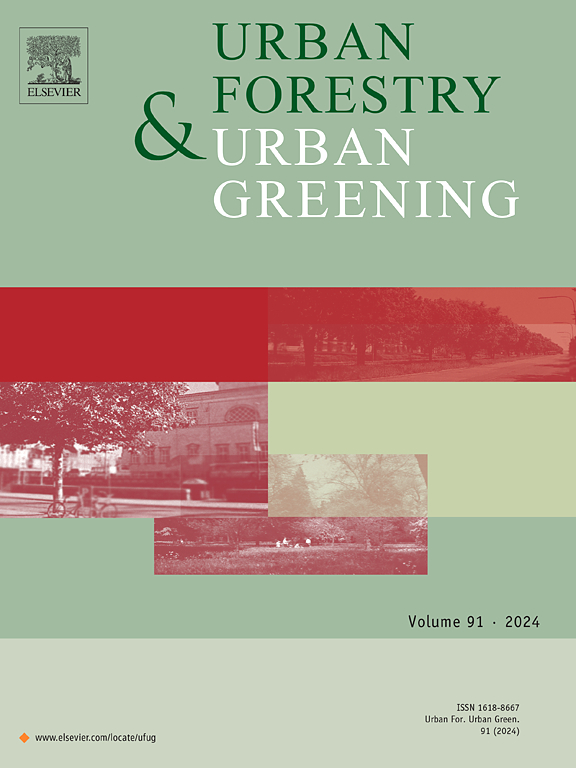提高城市绿地的固碳潜力:水-能-碳通量视角
IF 6
2区 环境科学与生态学
Q1 ENVIRONMENTAL STUDIES
引用次数: 0
摘要
在景观维护过程中调节碳排放对于增加城市绿地的净碳固存至关重要。本研究的重点是平衡水资源和能源的保护与增加碳固存。我们引入了一个综合的水-能源-碳通量框架来评估绿色空间的净碳固存,并开发了一个水-能源-碳可持续性指数(WECSI)来评估总体可持续性,强调碳固存潜力(CSP)。以浙江农林大学五种类型的城市绿地为例,研究发现不同类型绿地的生态承载力通量存在显著差异。具体而言,主要是乔木和封闭绿地(AC)类型由于规模效应而具有更大的CSP,而主要是演代短草和开放绿地(SGO)类型具有成为净碳源的风险。WECSI分析显示,同时实现节水、能源效率和净碳固存的难度很大,平均可持续性得分为0.57。为了最大化城市绿地的CSP,情景分析表明,低碳灌溉实践可以使CSP增加高达25% %,而来自花园废物的生物质能源可以减少与灌溉相关的碳排放19% %。这些研究结果为优化城市绿地管理,通过调节WEC通量最大化CSP提供了坚实的基础。本文章由计算机程序翻译,如有差异,请以英文原文为准。
Enhancing the carbon sequestration potential of urban green space: A water–energy–carbon fluxes perspective
Regulating carbon emissions during landscape maintenance is crucial for increasing net carbon sequestration in urban green spaces. This research focuses on balancing water and energy resource conservation with increasing carbon sequestration. We introduced an integrated water–energy–carbon (WEC) fluxes framework to evaluate the net carbon sequestration of green spaces and a water–energy–carbon sustainability index (WECSI) was developed to assess overall sustainability, emphasizing the carbon sequestration potential (CSP). Taking five types of urban green spaces at Zhejiang Agriculture and Forestry University as a case study, we observed significant differences in the WEC fluxes among the green space types. Specifically, mainly arbors and closed green space (AC) types had greater CSP due to scale effects, whereas mainly successional short grass and open green space (SGO) types were at risk of becoming net carbon sources. The WECSI analysis revealed the difficulties in simultaneously achieving water conservation, energy efficiency, and net carbon sequestration, with an average sustainability score of 0.57. To maximize CSP in urban green spaces, scenario analysis indicated that low-carbon irrigation practices could increase CSP by up to 25 %, whereas biomass energy from garden waste could reduce irrigation-related carbon emissions by 19 %. These findings provide a strong foundation for optimizing urban green space management to maximize CSP through WEC fluxes regulation.
求助全文
通过发布文献求助,成功后即可免费获取论文全文。
去求助
来源期刊

Urban Forestry & Urban Greening
FORESTRY-
CiteScore
11.70
自引率
12.50%
发文量
289
审稿时长
70 days
期刊介绍:
Urban Forestry and Urban Greening is a refereed, international journal aimed at presenting high-quality research with urban and peri-urban woody and non-woody vegetation and its use, planning, design, establishment and management as its main topics. Urban Forestry and Urban Greening concentrates on all tree-dominated (as joint together in the urban forest) as well as other green resources in and around urban areas, such as woodlands, public and private urban parks and gardens, urban nature areas, street tree and square plantations, botanical gardens and cemeteries.
The journal welcomes basic and applied research papers, as well as review papers and short communications. Contributions should focus on one or more of the following aspects:
-Form and functions of urban forests and other vegetation, including aspects of urban ecology.
-Policy-making, planning and design related to urban forests and other vegetation.
-Selection and establishment of tree resources and other vegetation for urban environments.
-Management of urban forests and other vegetation.
Original contributions of a high academic standard are invited from a wide range of disciplines and fields, including forestry, biology, horticulture, arboriculture, landscape ecology, pathology, soil science, hydrology, landscape architecture, landscape planning, urban planning and design, economics, sociology, environmental psychology, public health, and education.
 求助内容:
求助内容: 应助结果提醒方式:
应助结果提醒方式:


